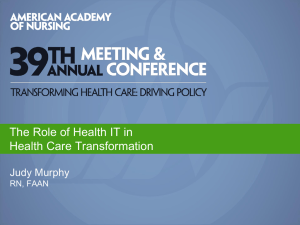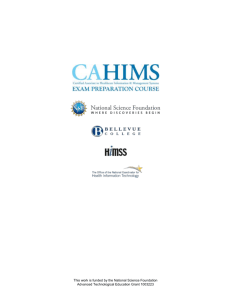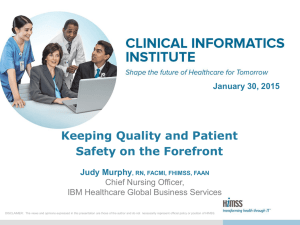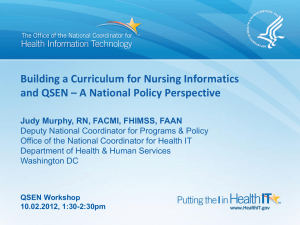HITECH and the Stimulus Bill More Funding and
advertisement
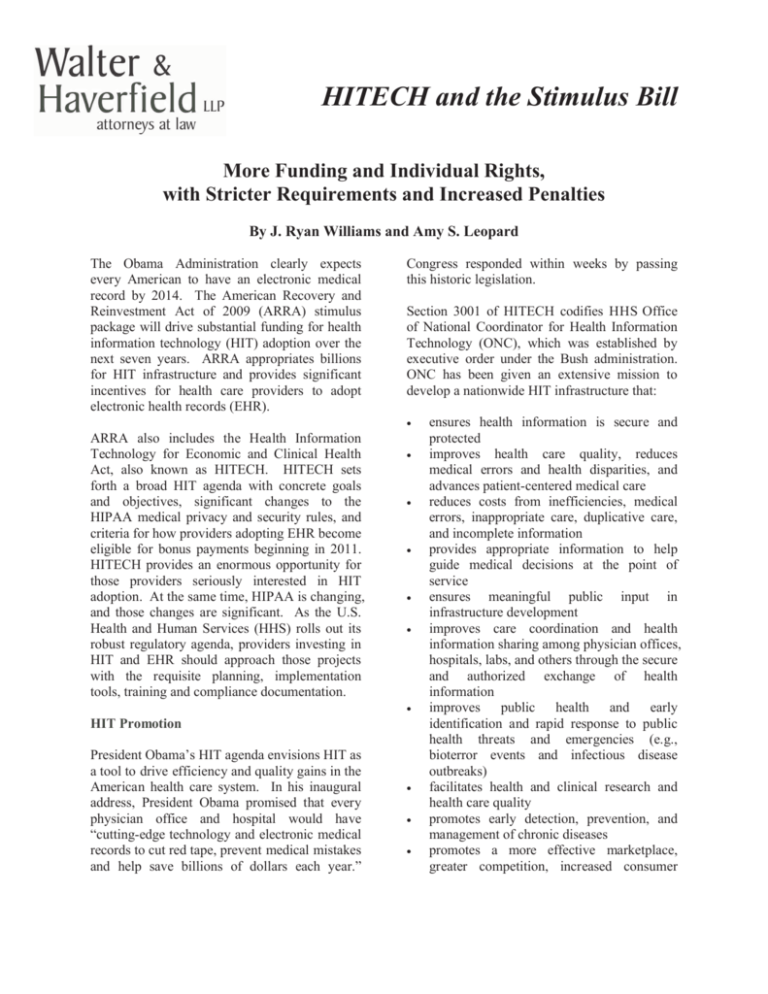
HITECH and the Stimulus Bill More Funding and Individual Rights, with Stricter Requirements and Increased Penalties By J. Ryan Williams and Amy S. Leopard The Obama Administration clearly expects every American to have an electronic medical record by 2014. The American Recovery and Reinvestment Act of 2009 (ARRA) stimulus package will drive substantial funding for health information technology (HIT) adoption over the next seven years. ARRA appropriates billions for HIT infrastructure and provides significant incentives for health care providers to adopt electronic health records (EHR). Congress responded within weeks by passing this historic legislation. Section 3001 of HITECH codifies HHS Office of National Coordinator for Health Information Technology (ONC), which was established by executive order under the Bush administration. ONC has been given an extensive mission to develop a nationwide HIT infrastructure that: ARRA also includes the Health Information Technology for Economic and Clinical Health Act, also known as HITECH. HITECH sets forth a broad HIT agenda with concrete goals and objectives, significant changes to the HIPAA medical privacy and security rules, and criteria for how providers adopting EHR become eligible for bonus payments beginning in 2011. HITECH provides an enormous opportunity for those providers seriously interested in HIT adoption. At the same time, HIPAA is changing, and those changes are significant. As the U.S. Health and Human Services (HHS) rolls out its robust regulatory agenda, providers investing in HIT and EHR should approach those projects with the requisite planning, implementation tools, training and compliance documentation. HIT Promotion President Obama’s HIT agenda envisions HIT as a tool to drive efficiency and quality gains in the American health care system. In his inaugural address, President Obama promised that every physician office and hospital would have “cutting-edge technology and electronic medical records to cut red tape, prevent medical mistakes and help save billions of dollars each year.” ensures health information is secure and protected improves health care quality, reduces medical errors and health disparities, and advances patient-centered medical care reduces costs from inefficiencies, medical errors, inappropriate care, duplicative care, and incomplete information provides appropriate information to help guide medical decisions at the point of service ensures meaningful public input in infrastructure development improves care coordination and health information sharing among physician offices, hospitals, labs, and others through the secure and authorized exchange of health information improves public health and early identification and rapid response to public health threats and emergencies (e.g., bioterror events and infectious disease outbreaks) facilitates health and clinical research and health care quality promotes early detection, prevention, and management of chronic diseases promotes a more effective marketplace, greater competition, increased consumer choice, and improved outcomes in health care services improves efforts to reduce health disparities HITECH affords the ONC a great deal of flexibility in implementing this robust HIT agenda. President Obama appointed Dr. David Blumenthal, a primary care physician and Harvard Medical School professor, as the new National Coordinator for HIT. Dr. Blumenthal is expected to bring significant health policy considerations to the position as the Obama administration links HIT adoption with health reform efforts. He will be advised by members of the new HIT Policy Committee, many of whom bring broad health policy experience to update the federal Health IT Strategic Plan. A HIT Standards Committee of HIT experts is also being appointed to recommend uniform standards, technical specification and certification criteria for HIT technologies. Federal and State Stimulus Funding HITECH includes substantial stimulus funding to encourage HIT adoption. Federal funding will be available to invest in the infrastructure needed for the nationwide health information network, assist with provider education and medical informatics programs, fund HIT/EHR research and development programs, provide grants to states to facilitate HIT acquisition, and fund extension programs and regional HIT centers to assist providers with implementing, operating and maintaining HIT. ONC will control a significant portion of the stimulus funds by awarding federal planning and implementation grants to states and statedesignated entities (with broad stakeholder representation) to jump-start HIT/EHR adoption. States are required to match at least 10% of any federal grants received from ONC. For example, by investing as much as $15M in state funds for HIT implementation, Ohio may be eligible for as much as $150M in matching federal funds. Rex Plouck, Governor Strickland’s point person for HIT, has stated that Ohio hopes to create a statedesignated entity for Ohio to help fund EHR software for physician practices and regional HIT extension centers for training and implementation assistance. Plouck has pointed Page 2 of 8 to health information exchange efforts as a forum for best practices to reduce duplicate tests, adverse drug interactions, and redundancies. Plouck envisions connecting physicians to results reporting for labs, medications, and imaging. The statewide organization could also serve as Ohio’s central contact for a nationwide electronic health information network. Incentive Payments to Providers Additional funding will be available directly to providers to encourage HIT/EHR adoption in the form of incentive payments through Medicare and Medicaid reimbursement. Medicare incentive payments for hospitals and physicians will begin in 2011 for those who can establish “meaningful use” of certified EHR technology. Incentive payments will be made over 5 years and are weighted with higher payments for early adopters. Medicare incentive payments can reach $44,000 for eligible physicians and up to $11 million for hospitals. For example, physicians demonstrating meaningful use by 2011 or 2012 will receive $18,000 in the first year, and $12,000, $8,000, $4,000, and $2,000 respectively over the following four years. Physicians practicing in a health professional shortage area (HPSA) can receive an additional amount of 10% in incentive payments. Hospital-based physicians (e.g., pathologists, anesthesiologists, or emergency physicians) would not be eligible for any incentive payments. On the other hand, physicians choosing not to adopt HIT/EHR and engage in meaningful use by 2015 face reductions in their Medicare fee schedule -- 1% in 2015, 2% in 2016, and 3% in 2017 (see Schedule A). For hospitals, a formula for Medicare incentive payments begins in FY 2011 and similarly phases down over time. The base amount available is $2M per year for eligible hospitals with add-on payments to the DRG payment over a 4-year period based upon the quantity of annual discharges, Medicare payor mix, and a transition factor (see Schedules B and C). For providers with a high volume of Medicaid patients, Medicaid program incentive payments may be available for meaningful use of certified EHR technology. Providers eligible for Medicaid program incentive payments include pediatricians, federally qualified health clinics (FQHCs), rural health clinics (RHCs), and physician assistants in physician assistant-led RHCs. Medicaid program incentive payments are an alternative to Medicare incentive payments, so eligible professionals must choose which incentive program carries the best benefits. Eligible Medicaid professionals could receive up to $63,750 in federal contributions towards the adoption, implementation, upgrade, maintenance, and operation of certified EHR technology. Subject to a cap on average allowable costs, up to 85% of $25,000, or $21,250, will be provided to eligible Medicaid professionals for certified EHR adoption, implementation, or upgrading and up to 85% of $10,000, or $8,500, to eligible Medicaid professionals to operate and maintain certified EHR systems for up to 5 years. High volume Medicaid hospitals and children’s hospitals with little Medicare revenue have alternative Medicaid program incentive payments as well. What Constitutes Meaningful Use? The concept that provider incentives are not tied to tangible investments in HIT is a fascinating aspect of HITECH. Rather, the incentives are intended to flow to those providers that can demonstrate meaningful use of certified EHR technology. Demonstrating that a provider is a meaningful user of certified EHR technology is difficult, at least for now. The demonstration should become easier when HHS develops a regulatory definition of meaningful use. HITECH requires that HHS base its definition of meaningful use on 3 core concepts: (1) the provider must demonstrate that it is using certified EHR technology in a meaningful manner, which shall include the use of appropriate e-prescribing; (2) the provider must demonstrate that the certified EHR technology is connected in a manner that Page 3 of 8 provides for the electronic exchange of health information to improve the quality of health care, such as promoting care coordination; and (3) the provider must submit information, in a form and manner specified by HHS, on such clinical quality measures and such other measures as selected by HHS. The core concepts for hospitals are similar without the e-prescribing component. Industry associations have already prepared comments to HHS as to the appropriate definition even in advance of rule making. A key component of meaningful use is the requirement that the provider use certified EHR technology. Under HITECH, certified EHR technology is qualified EHR technology that has been certified as meeting HHS standards for the type of record involved (e.g., ambulatory EHR for office-based physicians or inpatient hospital EHR for hospitals). Qualified EHR technology consists of electronic records of health-related information on an individual that include demographic and clinical information (e.g., medical history and problem lists) with functionality for clinical decision support, physician order entry, and quality information reporting. The technology also needs to exchange and integrate electronic health information with and from other sources. HHS has yet to establish the certification standards that it will use to certify qualified EHR technology. Nevertheless, some industry stakeholders believe that HHS will look towards CCHIT certification as one of the ways to meet the standard.1 HITECH Changes to HIPAA Besides providing incentives for EHR adoption, HITECH makes broad sweeping changes to HIPAA. Tucked away in the stimulus package are HITECH provisions that significantly change the rights and responsibilities of business associates while expanding privacy and security requirements for covered entities. 1 A detailed explanation of the CCHIT certification standards and process, along with a comprehensive list of all CCHIT certified EHR technology is available at the CCHIT website (http://cchit.org) and CCHIT’s EHR blog (http://ehrdecisions.com). Business Associates With the exception of certain standards and requirements applicable to business associate agreements, business associates are not currently required by law to comply with the security and privacy provisions of HIPAA that covered entities follow. This is no longer the case after HITECH. Starting February 17, 2010, business associates must implement the administrative, physical, and technical safeguards and comply with the organizational requirements of HIPAA. Business associates will need to, for example, appoint a security official, establish physical safeguards for individual workstations, implement technology to encrypt electronic PHI, and implement reasonable and appropriate policies and procedures to comply with the HIPAA security provisions. Business associates that desire to use or disclose PHI also must comply with each requirement of the privacy provisions applicable to business associate agreements. Effective as of February 17, 2010, business associates that do not comply and implement necessary security and privacy provisions will be subject to the civil and criminal penalties that currently apply to covered entities. Business associates under HIPAA may include: Administrative/billing companies Clearinghouses Attorneys and consultants EHR software vendors for providers Management companies Marketing firms PBM managing a health plan drug benefit. Third party administrators assisting health plan with claims processing Healthcare Staffing companies After HITECH, the definition of a business associate, by law, will also include certain organizations and vendors that contract with covered entities to provide services concerning PHI, such as vendors contracting with covered entities to allow the covered entity to offer patients a Personal Health Record as part of its HER, and organizations transmitting PHI to a Page 4 of 8 covered entity or its Business Associate that require access to the PHI on a routine basis, specifically Health Information Exchange Organizations, Regional Health Information Organizations, and e-Prescribing Gateways. Notice of Security Breach HITECH mandates that covered entities provide detailed notices to individuals when the covered entity discovers that unsecured PHI of the individual has been breached. This breach notice requirement applies only to unsecured PHI, which includes all PHI that is not secured through technology standards endorsed by HHS. Until such time as HHS issues guidance as to the appropriate technology standards for PHI, ANSI technology standards endorsed shall apply, for purposes of identifying unsecured PHI. A covered entity must make written notification to all individuals affected by the breach and must maintain a log of all breach incidents that will be reported to HHS on an annual basis. For major breaches involving more than five hundred individuals, the covered entity, in addition to individual notice, must notify HHS immediately and issue a public notice via all prominent media outlets serving the area in which the affected individuals reside. The notifications must include a brief description of the breach, description of the types of unsecured PHI involved, and steps that the covered entity is taking to investigate and resolve the breach. The mandatory breach notification requirements also apply to business associates, but only require the business associate to immediately notify the covered entity of the breach. The business associate’s notification to the covered entity must contain sufficient information to permit the covered entity to make the required disclosures. The covered entity and business associate must make all mandatory breach notices as soon as possible, but in no event later than 60 days following discovery of the breach. The breach notice requirements take effect thirty (30) days after HHS issues interim and final regulations, which must be promulgated by August 16, 2009. Stricter Restrictions on Disclosures When disclosures of PHI are permitted under HIPAA, the covered entity is required to take reasonable efforts to limit the PHI to the minimum necessary to accomplish the purpose of the disclosure. HIPAA is not entirely clear as to what constitutes minimum necessary, and in the absence of regulatory guidance, covered entities liberally interpret the minimum necessary requirement. HITECH requires HHS to issue affirmative guidance as to the meaning of minimum necessary. In the meantime, covered entities must limit all permitted disclosures to a limited data set of the PHI or, in limited circumstances, to the extent minimum necessary as determined by the disclosing covered entity. This requirement will take effect February 17, 2010, HHS must issue the guidance before the sunset date of August, 2010. Covered entities are permitted to disclose or use PHI when the disclosure or use is for treatment, payment or health care operations. In these circumstances, HIPAA permits individuals to request that covered entities restrict the disclosure or use of PHI. The covered entities are not required to agree to any such restriction. After HITECH, covered entries must follow the direct request of an individual to not disclose or use PHI when the disclosure or use is to a health plan for payment or health care operations and the PHI pertains to items or services for which the receiving provider received payment in full. Covered entities are prohibited from disclosing PHI for marketing purposes. To circumvent this prohibition, some covered entities have attempted to classify marketing disclosures as disclosures for health care operations. HITECH attempts to close this practice by specifically identifying communications that are marketing and not health care operations. Under HITECH, a communication concerning products or services that encourages recipients to purchase or use the product or service is a communication for health care operations only if the communication (a) describes products or services, (b) concerns the treatment of the individual, or (c) relates to case management services or care coordination. All other Page 5 of 8 communications concerning products or services encouraging the recipient to purchase or use the products or services are marketing communications and, with the exception of certain face-to-face communications, are prohibited when using PHI. Even if the communication is for health care operations, after HITECH, disclosing covered entities may not receive direct or indirect remuneration for such communications. HITECH requires fundraising communications to contain clear and conspicuous opt-out language. If the recipient opts out of the communication, covered entities must treat the opt-out as a revocation of any authorizations previously provided under HIPAA. Individual’s Right to an EHR Accounting HIPAA currently provides individuals a limited right to receive an accounting of the covered entity’s disclosures of the individual’s PHI. This right to an accounting does not apply to disclosures made for treatment, payment or health care operations. HITECH changes this and provides individuals with a right to receive an accounting of all disclosures of PHI made through EHRs for the purposes of treatment, payment, or health care operations. The right to an accounting applies only to disclosures through EHRs and the accounting period is limited to the three years prior to the request. The effective date for compliance depends on when the covered entity acquires the EHR in question. If the EHR was acquired on or before January 1, 2009, the covered entity must comply by January 1, 2014. If the EHR was acquired after January 1, 2009, the covered entity must comply by the earlier of the date of January 1, 2011 or the date that the EHR was acquired. In addition to an accounting, individuals may request a copy of their EHR in the electronic format maintained by the covered entity and instruct the covered entity to forward the EHR to any designated person at the entity’s labor cost only. These provisions of HITECH will significantly expand patient access to electronic formats that can be transmitted to RHIOs, health record data banks, or PHR vendors. Prohibition on Sale of EHR or PHI HIPAA does not explicitly prohibit the sale of EHRs or PHI. By no later than February 17, 2011, covered entities and business associates may not directly or indirectly receive remuneration in exchange for any EHR or PHI without a valid patient authorization. A limited number of exceptions to this rule apply for such things as public health activities, research, and treatment. New Penalties and Enforcement Avenues HITECH implements a new, tiered system of civil monetary penalties for HIPAA violations. Currently under HIPAA, violations carry a minimal, per-violation fine applied regardless of the violator’s intent. The tiered system increases the fines based on the violator’s intent. The tiered system works as follows: $100 per violation (capped at $25,000 per calendar year for identical violations) if violator did not know HIPAA was violated; $1,000 per violation (capped at $100,000 per calendar year for identical violations) if violation due to reasonable cause; $10,000 per violation (capped at $250,000 per calendar year for identical violations) if violation is due to willful neglect and is cured within 30 days of discovery; or $50,000 per violation (capped at $1.5 million per calendar year for identical violations) when any willful neglect violation is not cured within 30 days. In addition, HIPAA violators will be subject to the wrath of state attorneys’ general that will be permitted to enjoin further HIPAA violations and to seek damages on behalf of state residents. many metropolitan areas. For these physicians and hospitals with significant investment in HIT, paying close attention to the HHS rulemaking efforts to ensure that their particular technology is certified for purpose of demonstrating “meaningful use” is a priority. Most importantly, providers who have been considering the adoption of EHR technology will likely do so sooner now that the tipping point has been reached. The Medicare and Medicaid payment incentives are designed to do just that. The hope is that these incentives will ultimately off-set the start-up cost investment of a provider in HIT. This investment can be significant considering an initial license for an EHR system often ranges from $25-45,000 per physician together with ongoing maintenance and licensing fees ranging from $3,000 to $9,000 per physician annually.3 These amounts may be lower for ASP model licenses not requiring significant investment in hardware or operating systems and higher for robust EHR systems with sophisticated decision support. Since physicians have until January 2012 to establish “meaningful use” and receive full payments under the stimulus plan, hospitals will have until October 2012. After those dates, the total amount available is reduced. Prudence dictates that these decisions be made consistent with project management for the desired result with an eye toward incentive eligibility.4 Healthcare providers who have not yet thought about EHR technology should not run out and buy the first package without first considering their own requirements and incentive eligibility. The stimulus funding may be the tipping point for EHR projects seeking funding but, in reality, the incentive payments are designed to reward sustained use of EHR. Now what? Nationally, only 15-20% of physicians and 2025% of hospitals have implemented HIT systems, 2 although this adoption rate is higher in 2 “Accelerating Progress: Using Health Information Technology and Electronic Health Information Exchange to Improve Care,” in First Annual Report Page 6 of 8 and Recommendations from the State Alliance for eHealth (2008). 3 Id. 4 Physicians waiting until 2013 to establish meaningful use of a certified EHR technology are limited to $27,000 over 3 years. SCHEDULE A -- Physician EHR Incentive Amounts* First Pmt. Yr. Incentive Payment per Payment Year 1 $18,000 $18,000 $15,000 $12,000 $ $ $ - 2011 2012 2013 2014 2015 2016 2017 2 $12,000 $12,000 $12,000 $ 8,000 $ $ $ - 3 8,000 8,000 8,000 4,000 - $ $ $ $ $ $ $ $ $ $ $ $ $ $ 4 4,000 4,000 4,000 - $ $ $ $ $ $ $ Non-Adoption Penalty 5 2,000 2,000 - Total $44,000 $44,000 $39,000 $24,000 $ $ $ - $ $ $ $ -1% of Medicare fee -2% of Medicare fee -3% of Medicare fee SCHEDULE B -- Hospital EHR Incentive Formula* (Initial Amount) x (Medicare Share) x (Transition Factor) Initial Amount = $2,000,000 + $200/discharges for discharges 1,150 - 23,000 … if over 23,000 discharges = $6,370,000 Medicare Share = Medicare Part A days + Medicare Advantage days (Total days) (Total Charges - Charity Charges) X Total Charges SCHEDULE C -- Hospital Stimulus Transition Factor* First Pmt. Incentive Payment per Payment Year Non-Adoption Penalty 2011 2012 2013 2014 2015 2016 1 1.0 IP 1.0 IP 1.0 IP 0.75 IP 0.50 IP $ - 2 0.75 IP 0.75 IP 0.75 IP 0.50 IP 0.25 IP $ - 3 0.50 IP 0.50 IP 0.50 IP 0.25 IP $ $ - 4 0.25 IP 0.25 IP 0.25 IP $ $ $ - Total 2.50 IP 2.50 IP 2.50 IP 1.50 IP 0.75 IP $ - $ $ $ $ -25% of MBU and -33% remaining MBU -25% of MBU and -67% remaining MBU 2017 $ $ $ $ $ -25% of MBU and -100% remaining MBU - - - - * All Schedules courtesy of Dr. Brian Keaton Page 7 of 8 - The investment and alignment of EHR technologies within the nationwide health information highway has now begun with full force. State and regional HIT extension centers funded under HITECH, health information exchanges, IT vendors, financial institutions, and even hospitals will likely develop mechanisms to help physicians who may not have the internal resources to evaluate and/or fund EHR technology solutions. Stay tuned as the robust HHS regulatory agenda and state level initiatives roll out. Hospitals will need to pay attention to the definition of ‘meaningful use’ to ensure that the level of participation and connectivity is sufficient to meet the regulatory definition. Hospitals and health systems are reconsidering the Stark II Physician Self-referral exception and Antikickback safe harbors for donations to their referring physicians of interoperable technologies used predominately for EHR. Alternatives to the donation rules, such as physician employment, hospital portals and sublicensing of EHR software at a price consistent with fair market value are also getting attention. Each of these arrangements requires extensive compliance documentation and strict adherence with a Stark exception. In light of HITECH, now is a great time to reevaluate your business practices and relationships to determine how the new HIPAA rules apply to you and to monitor the upcoming regulatory changes. Let us know if we can help. For more information on this or other healthcare issues, contact one of our Healthcare lawyers: Robert J. Crump (216) 928-2933 direct dial rcrump@walterhav.com Mark S. Fusco (216) 619-7839 direct dial mfusco@walterhav.com Michael J. Jordan (216) 928-2922 direct dial mjordan@walterhav.com W. Clifford Mull (216) 619-7833 direct dial cmull@walterhav.com Charles R. Schaefer (216) 928-2894 direct dial cschaefer@walterhav.com John E. Schiller (216) 928-2941 direct dial jschiller@walterhav.com Amy S. Leopard (216) 928-2889 direct dial aleopard@walterhav.com J. Ryan Williams (216) 619-7847 direct dial rwilliams@walterhav.com The information in this advisory is a summary of often complex legal issues and may not cover all of the "fine points" of a specific situation or court jurisdiction. Accordingly, it is not intended to be legal advice, which should always be obtained in consultation with an attorney. Page 8 of 8

